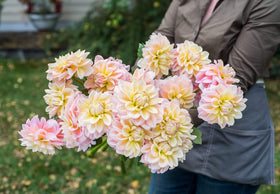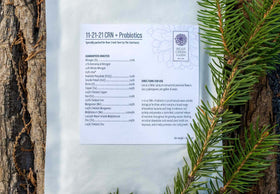In the Northeast dahlias are running late this year. (No, it is not you – keep on watching your beds.) Nature does not keep perfect time, but nor do we. Patience is a virtue. Challenges have presented - weather conditions have been hot and dry. Nevertheless, the dahlias should be coming (with a little help from some rain), and we at Bear Creek Farm are ready. So, while we wait (admittedly a tad impatiently, given our excitement for our flagship flower), we want to take a moment to share tips for harvesting dahlias once (finally) ready.
Here are some hints about what to look for when considering the best time to harvest your dahlia blooms - and the best ways to extend the life of your stems once cut.
- Harvest in early morning or in the cool as evening begins.
- Cut when almost fully open as dahlias do not open once cut.
- The outer petals should not be discolored or wilted. (Do not wait too long.)
- As with other flowers, always cut at the node. (The node is the part of the stem from which a leaf or two will emerge, often forming a knob-like feature.)
- Cut dahlias will last longer if lower foliage and buds are removed.
- Leaves and debris should never be in the vase water.
- As dahlias are hollow, they draw water up through the outer layers of the stem, so we recommend that you keep them in a lot of water.
- Pro tip: At Bear Creek Farm, we place them in water 160-180 degrees Fahrenheit because it helps them absorb water faster. That said, if this seems too “extra,” this is not necessary for the home gardener.
- Deadheading plants (pinching or trimming off spent blossoms) encourages other blossoms to open and makes the flower last longer. This maintenance (trimming spent blossoms, dead leaves) allows the bush to channel energy to the healthy parts and extends the life of your dahlia.

We like to think of you, dahlia growers, at all levels of experience harvesting the fruits of your labor. We marvel collectively at the sheer breadth and variety of the blooms. As the weather turns, dahlias signal a nod to the wonders of nature – unpredictable though they may be. (Note: As they are stressed, cut dahlias that have experienced drought could perform less than optimally in the vase - and their appearance different than prior years - so do not be too disappointed.)
Dahlias, dormant, of course in the off-season, are a bloom with the capacity to keep on giving. If tended the dahlia tubers can be dug up, put away, and replanted the following year. We like to think of them, sitting patiently in (as we are now), storing up their magic for the next season.
For those needing a little emboldening, for the ever-curious, or for those wishing to get their hands dirty, we offer exclusive workshops with industry leaders eager to train dahlia enthusiasts of all skill levels from novice to expert. These one-of-a-kind workshops are something special. (Sign up with a friend to receive a discount.) For more information, email us at info@bearcreekfarm.com.
Now that you've finished reading this article, you should check out our tulip planting primer, dahlia growing guide, and cutting guide for dahlias. And if you're shopping for dahlia tubers, make sure to check out our giant dahlia tubers (10"+ blooms), micro dahlia tubers (under 2" blooms), dark pink dahlia tubers, dark red dahlia tubers, and bicolor dahlia tubers.





I am a first year commercial Dahlia grower from Switzerland. www.vidaflores.ch
I marvel at the pure beauty of each flower starting to bloom this week. Thank you very much for your information which I will share with my customers so they will enjoy their blooms some days longer!
Thanks. This info was helpful, especially the hints about dead-heading and putting cut blooms in hot water.
FYI – I got blooms earlier this year in PA because I potted up my tubers in March, put them in my heated garage, and transplanted them in May with shoots already up. A few blooms in late July/early August instead of the usual September. Might have had even better success except for the exceptionally hot, dry weather (I’ve been trying to keep them watered, though).
Thanks for the tips. I oved wintered my tubers and replanted them (upstate NY) and they are indeed healthy but growing slowly.
This was helpful. Thanks!